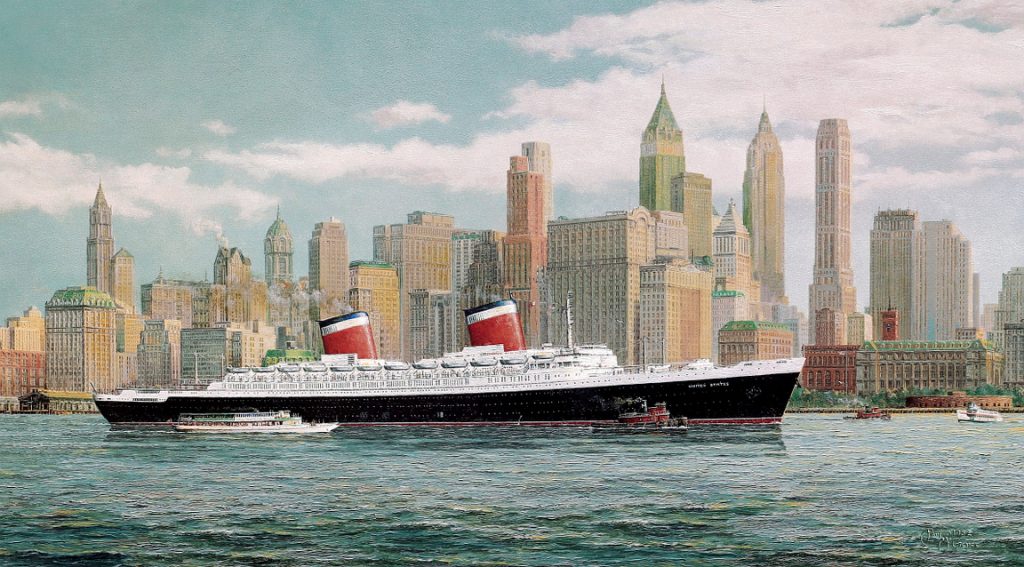New York harbor was teaming with tugs, barges, ferries, sightseeing boats, and the added excitement of the arrival of the SS United States. We were traveling south, headed for Brooklyn on our way home from a boating vacation on Lake Champlain. Moran tugs were getting into position to ease the great liner into the United States Lines pier.

Radio broadcasts announced that week that the SS United States had set a new transatlantic speed record on its maiden voyage, traveling from New York to England in just three days, ten hours, and 40 minutes. Fireboats were setting up streams of water, and boats of every description hovered around the great liner. It was a proud day for the Americans and a great day for American passenger ships. I was a young lad of 14 with a keen interest in boats. The following week, I took the subway into New York City and visited the offices of the United States Lines. My mother had purchased some stock in United States lines for me, so I brought the stock certificates. Once in the US Lines office, I asked, as a stockholder, for a pass to tour the great ship. The amused agent gave me a pass and directions on how to get to the US Lines Pier. I had no trouble getting on board. I had a free run of the ship, no questions asked, until I found myself in the engine room with a Roliflex camera hung around my neck. I had been exploring the engine room for a half hour when suddenly, a security guard challenged me. He said, “Don’t you know this is a top-secret area.” I said I did not and that I was sorry. The guard escorted me to the deck, but not before he demanded I give him the roll of film in my camera.
I spent the day going from one deck to the other, marveling at the beauty of this great ship. There were lots of red chairs and red carpets in the various lounges. At one point, one of the officers chatted with me and invited me to visit the bridge, a thrill I will forever cherish.
The SS United States was designed by the American naval architect William Francis Gibbs and commissioned by United States Lines in 1950. Newport News Shipbuilding and Drydock Company built her in Newport News, Virginia. Her cost was 71.8 million dollars. (In today’s dollars, $676 million) The keel was laid down in February of 1950, and she made her maiden voyage on July 3rd, 1952. The ship is 990 feet long with a beam of 101.5 feet, and her draft is 31 feet 3 inches. SS United States, powered by four Westinghouse double reduction geared steam turbines generating 240,000 hp turning four 18ft propellers, reached a speed of 56 knots, winning her the trans-Atlantic speed record.
In the glory days, celebrities like Frank Sinatra, Marlon Brando, Coco Chanel, Sean Connery, Gary Cooper, Walter Cronkite, Salvador Dali, Walt Disney, Duke Ellington, Judy Garland, Cary Grant, Charlton Heston, Bob Hope, Marilyn Monroe, Prince Rainier and Grace Kelly, Elizabeth Taylor, John Wayne, and the Duke and Duchess of Windsor traveled on the great ship. Unfortunately, the advent of commercial air flight to Europe sounded the death knell of the great ocean liners. Getting there fast became more important than getting there in luxury.
U.S Lines attempted to enter the SS United States into the cruise service when all trans-Atlantic travel was giving way to air travel. When US Lines finally went bankrupt, the ship was sold to a succession of cruise lines, all of whom intended to put the iconic ship in the cruise line business. None were successful due in part to the extensive use of asbestos by designer William Gibbs. Gibbs was unaware of the dangers of asbestos and wanted to avoid the danger of domed ships like the Morro Castle and the Normandie. The vast quantity of asbestos present made the cost of a restoration highly prohibitive. Shipyards were not interested in getting involved with the problems of working with asbestos.
Sadly, the mighty SS United States ended up tied up ignominiously, deteriorating at a pier in Philadelphia. Not totally forgotten, the SS United States Conservancy tried valiantly to restore the ship and preserve her as a hotel. SS United States Conservancy president Susan Gibbs, the designer’s daughter, told Sea History Magazine the ship will either have to be scrapped or turned into an artificial reef. “She will become a unique historical attraction above and below the waterline. A land-based museum and immersive experience utilizing the latest technology will showcase her unique story and proud history.” For over 28 years, she lay stripped and rusting when, finally, the pier owner demanded she be removed. With all possibilities of preserving the ship exhausted, she was sold to be scuttled and used as a massive reef. The Okaloosa, Florida Board of County Commissioners had agreed to buy the big U for 10 million dollars. A glimmer of hope emerged sparked by an article in Gothamist by Lian Quigley on November 19, 2024, which described the efforts by concrete magnet John Quadrozzi, Jr, to bring the ship to his Brooklyn pier, where it would be built up in increments to include residences, commercial spaces, and industrial space.
As exciting as the idea of finding a Brooklyn Home for the SS United States is, the SS United States Conservancy has issued a statement indicating that moving the ship to Brooklyn will not happen. As we write this, it appears that the SS United States will be scuttled in Florida. An American icon forever lost to an underwater grave to be visited by experienced divers. Rest in peace, mighty SS America; we are glad we knew you.
